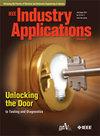Design and Validation of a Very Low-Power Phasor Measurement Unit for the Distribution System
IF 4.2
2区 工程技术
Q2 ENGINEERING, ELECTRICAL & ELECTRONIC
引用次数: 0
Abstract
Phasor measurement units (PMUs) provide a high-resolution view of the power system at the locations where they are placed. As such, it is desirable to place them in bulk in low-voltage distribution circuits. However, the power consumption of a PMU/micro-PMU is on the order of Watts (W), requiring an external power supply, which both increases the overall cost as well as limits the locations where they can be placed. This work details the hardware design of a PMU capable of measuring and reporting voltage and current phasors for a single-phase system at an average power consumption of only 30.8 mW—one to two orders of magnitude lower than existing academic and commercial PMUs. This enables the proposed PMU to run for two weeks using an 11-Wh battery or indefinitely if paired with an inexpensive solar panel. A test bench developed in accordance with the 2018 IEC/IEEE 60255-118-1 PMU Standard confirms the accuracy of this PMU, and a Fluke 6135A PMU calibration system evaluates its performance under realistic conditions. Given its low power consumption, the proposed design is expected to accelerate adoption of PMUs in modern distribution grids.配电系统极低功率相量测量单元的设计与验证
相量测量单元(pmu)在其放置的位置提供电力系统的高分辨率视图。因此,将它们批量放置在低压配电电路中是可取的。然而,PMU/微型PMU的功耗是瓦特(W)的数量级,需要外部电源,这既增加了总体成本,也限制了它们可以放置的位置。这项工作详细介绍了一个PMU的硬件设计,该PMU能够测量和报告单相系统的电压和电流相量,平均功耗仅为30.8 mw,比现有的学术和商业PMU低一到两个数量级。这使得所提出的PMU使用11-Wh电池可以运行两周,如果与廉价的太阳能电池板配对,则可以无限期运行。根据2018年IEC/IEEE 60255-118-1 PMU标准开发的试验台确认了该PMU的准确性,Fluke 6135A PMU校准系统在现实条件下评估其性能。鉴于其低功耗,所提出的设计有望加速pmu在现代配电网中的采用。
本文章由计算机程序翻译,如有差异,请以英文原文为准。
求助全文
约1分钟内获得全文
求助全文
来源期刊

IEEE Transactions on Industry Applications
工程技术-工程:电子与电气
CiteScore
9.90
自引率
9.10%
发文量
747
审稿时长
3.3 months
期刊介绍:
The scope of the IEEE Transactions on Industry Applications includes all scope items of the IEEE Industry Applications Society, that is, the advancement of the theory and practice of electrical and electronic engineering in the development, design, manufacture, and application of electrical systems, apparatus, devices, and controls to the processes and equipment of industry and commerce; the promotion of safe, reliable, and economic installations; industry leadership in energy conservation and environmental, health, and safety issues; the creation of voluntary engineering standards and recommended practices; and the professional development of its membership.
 求助内容:
求助内容: 应助结果提醒方式:
应助结果提醒方式:


